Lace Custom Paint Job
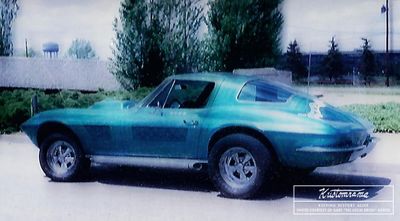
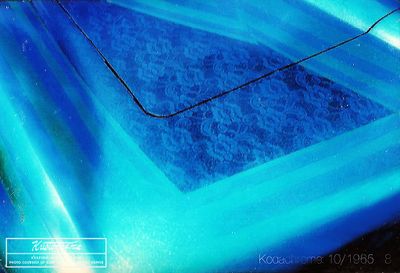


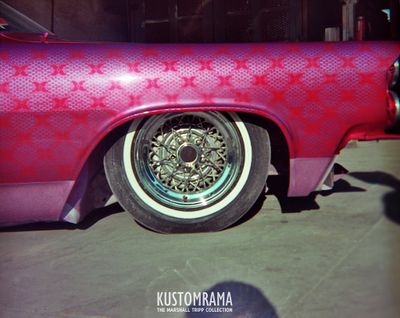
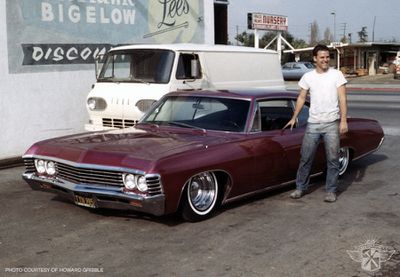

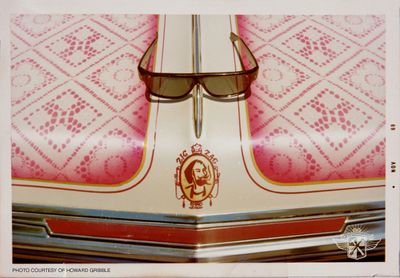
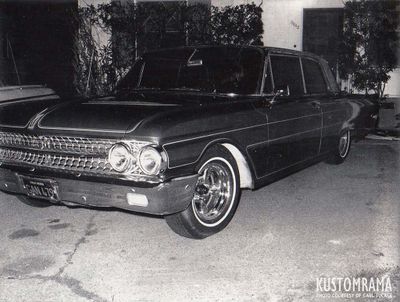

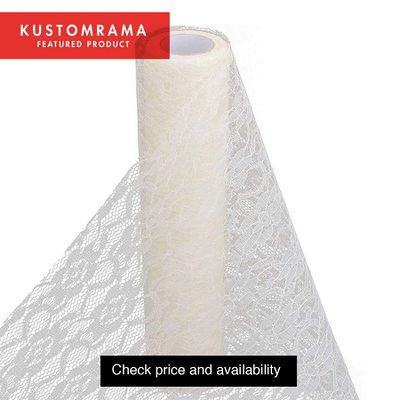

The lace custom paint job is a technique that gained popularity in the custom car culture during the 1960s, particularly in Southern California. The technique involves using lace fabric as a stencil to create intricate patterns on a vehicle's bodywork. This method of painting quickly became a defining feature of custom cars of the era and remains an iconic part of automotive history.
Contents
- 1 History
- 2 1965: Gary "The Local Brush" Kupfer and his Paisley Paint Job
- 3 1967: Larry Watson Paints Doug Carney's 1963 Pontiac Grand Prix
- 4 Marshall Tripp Recalls the "Silhouette" Paint on Carney's Grand Prix
- 5 Wait! But, What About Joe Andersen? Didn't he Invent the Lace Paint Job?
- 6 Tom Davison Brings the Craze to Kansas City
- 7 Popularity and Impact
- 8 Lace & Legacy
- 9 The Technique
- 10 Keith Christensen Explains How Larry Watson Laid a Lace Paint Job
- 11 Resources and How-To Articles
- 12 Custom Cars Featuring Lace Paint Jobs
- 13 References
History
The origins of the lace paint job can be traced back to the custom car culture of the 1950s and 60s. During this time, car enthusiasts would often modify their vehicles with custom paint jobs, chrome detailing, and other modifications to make them stand out on the road. Lace paint jobs became popular as a way to add a touch of elegance and femininity to a car.
1965: Gary "The Local Brush" Kupfer and his Paisley Paint Job
For many years, Larry Watson of Watson's House of Style was recognized as the inventor of the lace paint job, as he debuted Doug Carney's 1963 Pontiac Grand Prix with a lace paint job at an indoor car show in April 1967. However, recent information has surfaced that challenges this claim, and it seems that Gary "The Local Brush" Kupfer of Roosevelt, New York, might have been the actual inventor of the technique. In November 1966, five months before Watson's famous debut, Kupfer showed his panel and lace-painted 1963 Chevrolet Corvette at the ISCA New York Coliseum Show. According to Kupfer, no one knew what it was at the time, and people referred to it as the "paisley paint job." The following year, almost half the cars at the same show featured lace paint jobs. Kupfer has always been aware that Larry Watson has been attributed to doing the first lace paint job but acknowledged that California received more recognition as the Mecca of custom car culture, overshadowing the East Coast's contributions.[2]
Gary Kupfer is a graduate of the School of Visual Arts in New York City. "In my first year at SVA in 1965, there was another student who was using spray cans & inanimate objects to create silhouette shapes on canvas," Kupfer told Sondre Kvipt of Kustomrama late in 2022. "He used things like leaves, torn paper & a small piece of lace & much more. What I noticed was the detail that the lace provided. At that same time, I was in the midst of custom painting my own personal Corvette. I had already panel painted it with Candy Apple Green and Blue, and at that moment decided to use lace for the center panels. It was a risky move, especially when I mentioned lace to my friends. I had to experiment and practice first. I then Metalflaked a Masonite panel, and after clear coating it, I used two different types of lace to see which one would look better." After experimenting and practicing on the panel, Kupfer successfully applied the lace paint job technique to his Corvette, predating Watson's famous work. As of today, the origin of the lace custom paint job technique, therefore, can be traced back to Gary Kupfer in the mid-1960s in New York City. Southern California, with its thriving car culture and creative atmosphere, provided an ideal environment for the technique to gain popularity, with Larry Watson playing a key role in promoting the method.[2]
1967: Larry Watson Paints Doug Carney's 1963 Pontiac Grand Prix
Tired of working from 12 to 20 hours a day, seven days a week, Larry Watson decided to sell the shop he had in Paramount in 1966 and move to Mexico to pursue an acting career with his wife. He returned to California late in 1966 and opened up a new shop in Bellflower. Determined that he had to get his name back on the show circuit, Larry decided to do something completely new for the upcoming show at the Los Angeles Sports Arena in April 1967. He was painting Doug Carney's 1963 Pontiac Grand Prix for the show and decided to do a lace paint job on the car. Larry had never tried the technique before, but Von Dutch had told him about a doily that he had on a bench in his shop. One day while cleaning up in the shop, he had removed the doily, and a beautiful overspray pattern had been left on the bench. Von Dutch dug the design and painted clear all over it. While wondering about what to do with Doug's Pontiac, Larry remembered this story and decided to paint the whole side of the car using a lace pattern with Lucky Lager Double X Pattern. Larry's newly painted Pontiac made it's debut at the April 1967 show together with 53 other cars in the center arena of the car show, who was sponsored by the Tridents Car Club. At the same show, Watson also had over two dozen motorcycles upstairs.[3]
Marshall Tripp Recalls the "Silhouette" Paint on Carney's Grand Prix
Marshall Tripp worked for Watson between 1966 and 1967, prepping, sanding and masking cars. Marshall was at the shop when Doug Carney brought his Grand Prix in for a full custom paint job. "It had lifts front and rear and the interior was a "chick magnet," Marshall told Sondre Kvipt in 2017, adding that it also ran Buick wires with little mirrors in the center cap. "I liked this car already but after it had it's Fuchsia color with tasteful Metalflake trim with webbing I loved it. For me, this was the ultimate car. The car only needed its color sand and rub and it was done, or so I thought. I liked this car so much I still have some of the masking material from the Fuchsia color. When I came to work in the morning it sat there with the addition of the "Silhouette" effect on the sides. Larry had stayed late and put the finishing touch on this car. Lace painting was born with what Watson called Silhouette painting. I remember seeing an ad somewhere saying "Come to Watsons and see the new Silhouette paint job." This car became a sensation all over Southern California. All of the sudden people were showing up every day to see it. Larry never told me how it was done but others figured it out. By the time of the next car show, there were 3 or 4 other lace paint jobs but none could touch the Pontiac."[4] The new technique spread quickly around the Bellflower-area, and according to Roger O'Dell, everyone with spare bucks got lace, either on the whole car or on panels or rooftops.[5]
Wait! But, What About Joe Andersen? Didn't he Invent the Lace Paint Job?
Many believe that custom painter Joe Andersen invented the Lace Paint technique as he demonstrated it in the Rod & Custom March 1968 issue, one year after Larry painted Doug's Pontiac.[6]
Tom Davison Brings the Craze to Kansas City
Tom Davison of Raytown, Missouri was in Los Angeles at the Carney Pontiac’s first show at Great Western. "I beat it back home to Kansas City, determined to incorporate lace into the paint design of my new ‘66 Riviera," Tom told Kustomrama's readers in September of 2023. "The hard part was finding “lace” pattern that was geometric like Larry’s (not scrolls and flowers). I settled for a lesser pattern just to get it done." According to Tom, Larry's brilliance, aside from the concept itself, was that he found a geometric pattern the likes of which he never could find. After completing the Riviera, Tom won best paint at Farhner’s show in Des Moines. "Lee Pratt saw it there and asked me to paint his custom Nomad purple, incorporating lace, pearl, and candy. Lee designed the paint scheme, and I mixed and sprayed it in the fall of ‘67. It won best paint at the Detroit Autorama."[7]
Popularity and Impact
The lace custom paint technique quickly gained popularity among custom car enthusiasts in the 1960s, who appreciated its unique aesthetic and the ability to make their vehicles stand out from the crowd. The technique became a symbol of the era's creativity and self-expression, capturing the spirit of the times. Many renowned custom car builders and painters adopted and popularized the lace custom paint job technique. Their work has been featured in car shows, magazines, and even films, further cementing the technique's legacy in automotive culture.
Lace & Legacy
In the 1970s and the 1980s, lace paint jobs fell out of fashion as more garish and bold designs took center stage. However, they made a comeback in the 1990s and 2000s as a new generation of car enthusiasts rediscovered the almost forgotten technique. Today, lace paint jobs are once again a popular choice for those looking to add a touch of elegance and uniqueness to their car. The method has been adapted for use on motorcycles, bicycles, and even home décor items. Today, the lace custom paint job serves as both a nostalgic nod to the past and a testament to the enduring appeal of innovative self-expression.
The Technique
The lace custom paint job technique involves several steps, which include:
- Preparing the surface: The car's surface is thoroughly cleaned and sanded to ensure proper adhesion of the paint.
- Base coat: A base color is applied to the car's surface. This color will be visible through the lace pattern and can significantly impact the overall appearance of the finished paint job.
- Lace application: A piece of lace fabric with a desirable pattern is carefully placed over the area to be painted. The fabric is stretched tight and held in place using tape or magnets to prevent movement during the painting process.
- Topcoat: A contrasting color of paint is sprayed over the lace, covering the area completely. The paint should be applied evenly to achieve a consistent finish.
- Removal and clear coat: Once the topcoat has dried, the lace is carefully removed, revealing the intricate pattern beneath. A clear coat is then applied to protect the paint and add a glossy finish.
Keith Christensen Explains How Larry Watson Laid a Lace Paint Job
There are several different techniques that can be used to create a lace paint job. Keith Christensen helped Larry Watson lay down a couple of lace paint jobs in the 1960s. "Lacing the sides of a car was marvelous," Keith Christensen recalled, "I helped Larry with a couple of lacing jobs. We would set up saw horses on either side of the car and have to position them perfectly - just inches away from the side of the car - tedious and critical. Then we would take an expensive lace tablecloth and stretch it between the sawhorses - even more critical a distance. This is all after the car had just been painted some wild Candy or Pearl." The finesse of the next step was the crucial step, Keith remembered; "Larry had only one pass along the side of the car to fog through the lace. He would take a beautiful paint color and turn the pressure of the paint gun up and walk the full length of the car in one long smooth, balanced sweep. A real test of talent as Larry would not have a second chance, as the paint would fog through the lace tablecloth and onto the side of the car, and had to land perfectly and equally - No second chance. If it was not perfect, the whole side of the car had to have the lacing fog taken off." According to Keith, "Larry's intricate preparation and his talent came out in all this. The paint jobs were the talk of the town and won awards at a lot of car shows."[8]
Resources and How-To Articles
- In The Garage Media: Part 2: Wrapping Up The Custom Panel & Lace Paint Job
- MotorTrend: How to Do Lace: Old School Custom Paint Tricks
- BangShift.com: Paint How To: Paint A Lace Roof On Your Ride For Cheap!
Custom Cars Featuring Lace Paint Jobs
- Carl Darling's 1961 Ford Starliner
- Carl Tucker's 1961 Ford
- Gordy Brown's 1963 Ford Thunderbird
- Doug Carney's 1963 Pontiac Grand Prix
- Gary "The Local Brush" Kupfer's 1963 Chevrolet Corvette
- Tom Davison's 1966 Buick Riviera
- Howard Gribble's 1967 Chevrolet Impala
References
Did you enjoy this article?
Kustomrama is an encyclopedia dedicated to preserve, share and protect traditional hot rod and custom car history from all over the world.
- Help us keep history alive. For as little as 2.99 USD a month you can become a monthly supporter. Click here to learn more.
- Subscribe to our free newsletter and receive regular updates and stories from Kustomrama.
- Do you know someone who would enjoy this article? Click here to forward it.
Can you help us make this article better?
Please get in touch with us at mail@kustomrama.com if you have additional information or photos to share about Lace Custom Paint Job.
This article was made possible by:
SunTec Auto Glass - Auto Glass Services on Vintage and Classic Cars
Finding a replacement windshield, back or side glass can be a difficult task when restoring your vintage or custom classic car. It doesn't have to be though now with auto glass specialist companies like www.suntecautoglass.com. They can source OEM or OEM-equivalent glass for older makes/models; which will ensure a proper fit every time. Check them out for more details!
Do you want to see your company here? Click here for more info about how you can advertise your business on Kustomrama.





